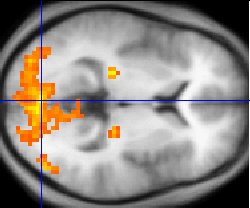Functional magnetic resonance imaging facts for kids
Functional Magnetic Resonance Imaging, or fMRI for short, is a cool way to look inside your brain! It's a special type of MRI scan. Imagine being able to see which parts of your brain are busy when you're thinking, talking, or even just resting. That's what fMRI helps scientists do!
What is fMRI?
fMRI stands for Functional Magnetic Resonance Imaging. It's a powerful tool used by scientists and doctors. It helps them understand how the brain works. This scan shows how much oxygen different parts of your brain are using. When a part of your brain is active, it needs more oxygen. fMRI can see these changes in oxygen levels. This lets us see which brain areas are "lighting up" during different tasks.
How does fMRI work?
fMRI works by looking at your blood. Your blood carries oxygen using a special protein called Hemoglobin. Hemoglobin changes slightly when it has oxygen (oxyhemoglobin) or when it doesn't (deoxyhemoglobin).
The fMRI machine sends out a harmless radiowave signal. Deoxyhemoglobin in your blood absorbs this signal. Then, it sends the signal back out. Oxyhemoglobin does not absorb the signal in the same way.
When a part of your brain is working hard, more blood flows to that area. This blood brings lots of fresh oxyhemoglobin. So, there's less deoxyhemoglobin in that active spot. This means less of the signal is absorbed there. The fMRI machine detects these tiny differences. It creates a picture showing which brain areas are using more oxygen. These areas appear brighter on the scan.
Why is fMRI important?
fMRI is very important for understanding the brain. It helps scientists learn about:
- How we think and make decisions.
- How we feel emotions.
- How we learn new things.
- What happens in the brain when someone has a brain injury or illness.
Doctors can also use fMRI before brain surgery. It helps them find important brain areas. This way, they can avoid damaging them during an operation.
Images for kids
See also
 In Spanish: Imagen por resonancia magnética funcional para niños
In Spanish: Imagen por resonancia magnética funcional para niños





